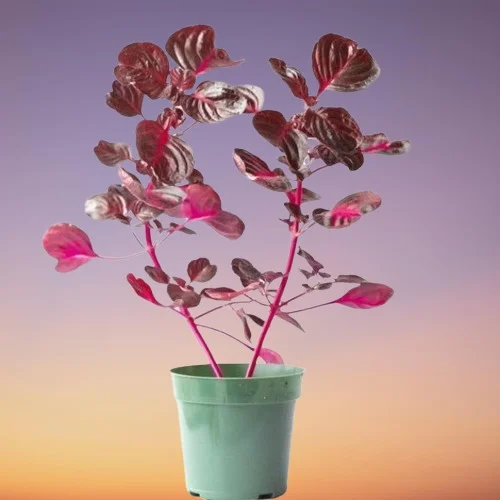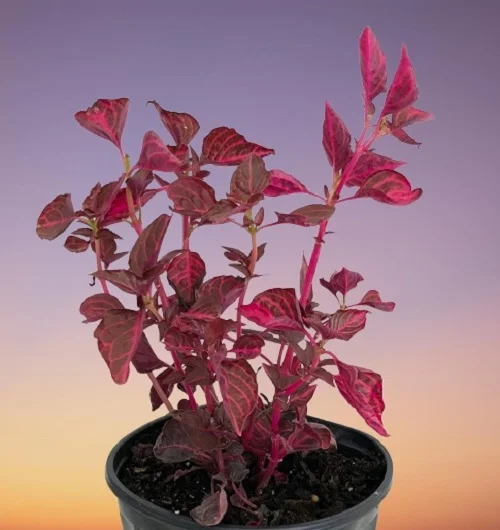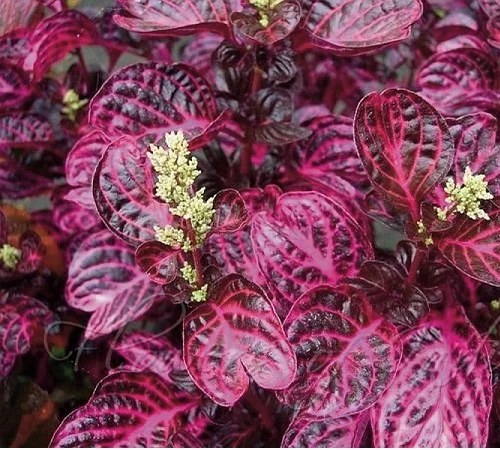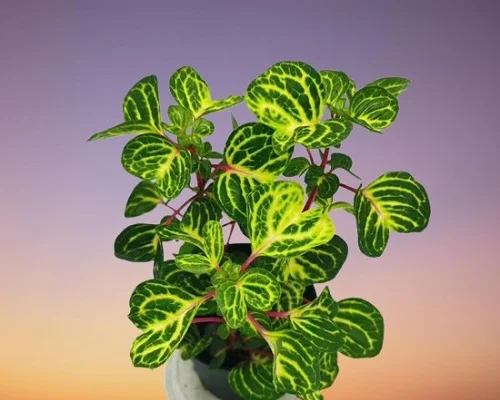How to Grow and Care for Iresine herbstii (Bloodleaf Plant) Indoors & Common Probems
Last updated on
Some links in this post may be affiliate links
Bloodleaf Plant (Iresine herbstii) requires very bright light with some sunlight, warm and humid conditions, and consistently moist, rich, well-drained soils coupled with fortnightly feeding in the growing season.
With proper care, Iresine herbstii thrives indoors, offering lush, bushy growth year-round. This guide covers everything you need to know about growing and maintaining Bloodleaf Plants indoors, including light, watering, pruning, soil, and propagation techniques.
Iresine herbstii also called Beef Steak Plant or Red Iresine is a striking plant with wine-red stems and rounded or lance-shaped leaves with prominent red veins and can grow to a height of 2 feet.

Botanical name: Iresine herbstii
Family: Amaranthaceae
Common names: Bloodleaf Plant, Beef Steak Plant, Red Iresine, Herbst Bloodleaf
Origin
Iresines are native to the American tropics where the growing conditions are warm, moist and humid.
Flowers
Iresine herbstii flowers are small, greenish-white and are not as conspicuous as the brightly colored leaves. Pinch off the flowerbuds as soon as they begin to form so that the plant can direct its energy to growth other than developing the flowers.
Bloodleaf Plant Varieties
Herbst Bloodleaf is one of the common Iresine varieties grown in the home. The other common variety Iresine herbstii aureoreticulata (Chicken Gizzard) bears red stems and green leaves with yellow veins.
Is Bloodleaf Plant toxic to pets?
No. According to ASPCA, Bloodleaf Plants are non-toxic to humans and pets. Iresine herbstii are non-toxic to cats and dogs. However, the sap may cause irritation on sensitive skin. It is advisable to always wear gloves when handling this plant.
Why grow Bloodleaf Plant indoors?
- Fast growth: It quickly fills up pots, making it ideal for lush indoor greenery.
- Striking foliage: Its deep red, pink, or purple leaves add a bold touch to any space.
- Low maintenance: Easy-care, good for beginners.
- Adaptable : Flourishes in various indoor conditions.
Where to Buy
Are you looking to add these beauties to your collection? You may acquire Bloodleaf Plants online from Etsy (Link to Etsy).
How to Care for Iresine herbstii Indoors
To care for Iresine herbstii indoors, provide very bright light with 4-6 hours of sunlight, warmth of 18-260C, humidity of 55-65% and consistently moist, rich, well-drained potting mix coupled with fortnightly feeding during the growing season.
Bloodleaf Plant care needs regular pruning to keep it neat, to discourage pests and to control growth. Repotting is only necessary when it becomes pot-bound. Keep reading for more on these growing conditions and how to achieve them.

Watering
How often should I water Bloodleaf Plant?
Water your Bloodleaf Plant liberally in spring and summer while allowing the top 1-2 inches of soil to dry out between waterings to keep the soil consistently moist. Avoid overwatering; it causes yellowing leaves and weak stems.
Decrease watering in fall and winter to keep the soil slightly moist as growth is reduced at this time. Do not let the soil dry out completely to avoid brown-edged, wilting and drooping leaves.
Use water that is at room temperature to prevent shock which can lead to stunted growth and leaf loss. Avoid chlorinated water to avoid brown leaf tips and edges; use rain water or filtered water.
Ensure that the pot has a drainage hole to prevent the soil from getting soggy as it can lead to root-rot and eventual death of the plant.
Light Requirements
Do Bloodleaf Plants like sun or shade?
Bloodleaf Plant grows best in very bright light with 4-6 hours of morning or late afternoon sunlight to enhance the leaf color and prevent legginess. However, protect it from hot midday sunshine as it can cause scorching resulting in ugly brown marks on the leaves.
Too little light will cause the leaves to lose their vibrant color and become dull or greenish. Use a grow light in low-light spaces.
Regularly rotate the pot to ensure that the plant receives light on all sides for even growth and prevent leggy growth.
On account of its need for exposure to direct sunshine, Iresine herbstii is among the sun loving plants that will thrive under direct sunlight.
Temperature & Humidity
Herbst Bloodleaf thrives in an average warmth of 18-260C. Keep it away from drafty windows and doors as the drafts can cause leaf drop and reduced growth.
Bloodleaf Plant blossoms in a humidity of 55-65%. Low humidity will result in brown leaf tips and edges. To increase humidity, set the pot on a wet pebble tray or use a humidifier. Ensure that there is good air circulation to prevent fungal diseases.
Fertilizer
Feed your Beef Steak Plant with a balanced, liquid fertilizer every 2 weeks in spring and summer to promote a lush growth.
Do not feed in fall and winter as the growth is minimal at this time and feeding at this time may cause fertilizer burn.
Potting Mix
The best potting mix for Bloodleaf Plant should be rich in organic matter and free-draining to prevent it from getting soggy while providing the required nutrients. A blend of 2 parts of all purpose potting mix and 1 part perlite is recommended for this plant.
Repotting
Repot your Bloodleaf Plant during the growing season (spring and early summer), only when the roots grow out of the drainage holes as it prefers to be root-bound.
Use a pot 1-2 sizes larger and one that has a drainage hole to prevent the soil from getting soggy to avoid root-rot. Take a look at these self watering planters with drainage hole on Amazon.
Pruning & Grooming
Pruning Herbst Bloodleaf involves removing dead or yellowing leaves to keep the plant neat and healthy.
Pinch off the growing tips regularly to control growth and encourage a compact, bushy growth.
Cutback the tall stems during the growing season to prevent the plant from becoming leggy to maintain a bushy shape.
Regularly clean the leaves by damp-wiping with a soft cloth to get rid of dust and also discourage pest and disease infestations.
Propagation: How to Multiply Bloodleaf Plant
Iresine herbstii propagation is easily done at the beginning of the growing season from stem cuttings which you can root either in water or in soil.
Learn how to propagate Iresine herbstii (Bloodleaf Plant) from stem cuttings.

Iresine herbstii Problems & Remedies
Bloodleaf Plant (Iresine herbstii) problems are wilting and drooping, plant dying, yellow leaves, brown leaf tips and edges, loss of leaf color, leggy growth, pest infestations among others. We have outlined herebelow the remedies and solutions. Keep reading for more on these problems.
Wilting and drooping
Wilting and drooping on Bloodleaf Plant may be caused by poor lighting, pests infestations, wrong soil, nutrients deficiency, inconsistent watering, root-rot among others.
Read more on these 13 Reasons Why Bloodleaf Plant is Wilting and Drooping (with Solutions).
Plant dying
Why is my Bloodleaf Plant dying?
Your Bloodleaf Plant is dying due to root-rot disease which is prevalent in soggy soil due to poor soil drainage. The disease is characterized by rotting, yellowing, browning and eventual collapse of the plant.
How to fix it
- Slip the plant out of its pot, wash off the soil and inspect the roots.
- Brown-black, mushy roots indicate root-rot; cut them away. In addition, cut away any stems showing any signs of rot.
- Disinfect the healthy roots and the entire plant with a copper-based fungicidal solution as indicated by the manufacturer.
- Disinfect the pot with the fungicidal solution or use a fresh pot to repot the plant in fresh potting soil.
- Ensure that the pot has a drainage hole and the soil is well-draining to prevent waterlogging.
- Water the plant with the fungicidal solution and place it in a warm, brightly-lit spot.
- Do not water the plant again until new growth appears and avoid overwatering and soggy soil thereafter.
Yellow leaves
The main causes of yellow leaves on Iresine herbstii are too little light, dry air, inconsistent watering, soggy soil and aging.
How to fix it
Remove such leaves by snipping them off at the base with a clean sharp knife or a pair of scissors.
Too little light: Position the plant in bright light with some direct sunshine or use a grow light if the natural lighting is not adequate.
Dry air: Set the pot on a wet pebble tray, group the plants together, use a cool mist humidifier or grow the plant in a well-lit bathroom.
Inconsistent watering: Water only when the top 1-2 inches of soil dry out. Do not water on a schedule.
Soggy soil: Use well-draining soil and a pot that has a drainage hole.
Aging: It is natural for the old leaves to turn yellow and drop as the plant matures.
Brown leaf tips and edges
Brown leaf tips and edges on Bloodleaf Plant are caused by low humidity, salts buildup or underwatering.
How to fix it
Low humidity: Set the pot on a wet pebble tray or use a humidifier to elevate humidity.
Salts buildup: Regularly flush out accumulated salts from the soil by running a stream of water through the soil until it drains through the drainage hole.
Underwatering: Water when the top 1-2 inches of soil dry out but never allow the soil to dry out completely.
Loss of leaf color
Loss of leaf color on Bloodleaf Plant on due to too little light. Position the plant in a brighter spot where it will receive bright light with at least 4-6 hours of direct sunlight or instal a grow light where natural light is not adequate.
Leggy growth
Leggy growth (elongated stems) on Bloodleaf Plant are due to low light. Move the plant to a brighter spot with bright light and 4-6 hours of direct sunshine or use a grow light if natural lighting is not sufficient.
Pests
Bloodleaf Plant is prone to aphids, spider mites and whiteflies infestations. These sap-sucking insects are attracted to the new soft growth of the plant where they cause distorted growth.
How to fix it
- Isolate the affected plant to prevent spread to the other plants.
- Treat the plant with neem oil or an insecticidal soap. Ensure to follow the manufacturers' instructions on the label.
- Regularly damp-wipe the leaves with a soft cloth to discourage the pests.
- Maintain the plant well pruned to discourage the pests.
- Set the pot on a wet pebble tray or group the plants together to raise humidity to minimize the pests infestations.
Conclusion
Bloodleaf Plant (Iresine herbstii) is a stunning, low-maintenance plant that adds bold color to any indoor space. By providing proper lighting, watering, and occasional pruning, you can enjoy this vibrant plant year-round.
Frequently Asked Questions
1. Is Bloodleaf Plant indoor or outdoor?
Bloodleaf Plant also called Beef Steak Plant is a good plant for gardens and landscapes in the warm climates making it is ideal for USDA zones 10-12. In the colder climates it is grown as an indoor plant or as a container plant that can be brought inside during winter.
2. How do you take care of a Bloodleaf Plant?
Bloodleaf Plant flourishes in very bright light with 4-6 hours of direct sunlight, average warmth of 18-260C, moderate to high humidity between 55 and 65% and consistently moist, rich, well-drained soils coupled with fortnightly feeding during the growing season.
3. Bloodleaf Plant Propagation?
Bloodleaf Plant can be propagated at the beginning of the growing season from stem cuttings which can be rooted either in water or in soil.
4. Do Bloodleaf Plants like sun or shade?
Bloodleaf Plants prefer a sunny location with very bright light and 4-6 hours of direct sunlight. They require some direct sunlight to enhance the leaf color. When grown in too much shade they loose leaf color and also become leggy.
5. How often should I water Bloodleaf Plant?
Do not water on a schedule. Water your Bloodleaf Plant thoroughly during the growing season and allow the top 1-2 inches of soil to dry out between waterings to keep the soil consistently moist.
Cut down on watering during the cold period to keep the soil slightly moist as growth is reduced at this time but do not allow the soil to dry out completely.
6. Can Bloodleaf Plant grow in low light?
Bloodleaf Plant can survive in low light, but the colors may fade, and growth will slow.
7. Why are my Bloodleaf Plant’s leaves turning green?
Bloodleaf Plant leaves may turn green when the plant doesnot get enough light. Move it to a brighter location.
8. How fast does Bloodleaf Plant grow?
Bloodleaf Plant grows quickly, especially in warm conditions with proper watering and fertilizing.
9. Is Bloodleaf Plant toxic to pets?
No, Bloodleaf Plant is non-toxic to cats and dogs.
You liked it? Share on social media.
Related Content
Amazon Associates Disclosure
Homeplantsguide.com is a participant in the Amazon Services LLC Associates Program, an affiliate advertising program designed to provide a means for sites to earn advertising fees by advertising and linking to amazon.com.




